

Compact Muon Solenoid
LHC, CERN
| CMS-HIN-21-004 ; CERN-EP-2023-085 | ||
| Study of charm hadronization with prompt $ \Lambda_{c}^{+} $ baryons in proton-proton and lead-lead collisions at $ \sqrt{\smash[b]{s_{_{\mathrm{NN}}}}} =$ 5.02 TeV | ||
| CMS Collaboration | ||
| 20 July 2023 | ||
| JHEP 01 (2024) 128 | ||
| Abstract: The production of prompt $ \Lambda_{c}^{+} $ baryons is measured via the exclusive decay channel $ \Lambda_{c}^{+}\to\mathrm{p}\mathrm{K^-}\pi^{+} $ at a center-of-mass energy per nucleon pair of 5.02 TeV, using proton-proton (pp) and lead-lead (PbPb) collision data collected by the CMS experiment at the CERN LHC. The pp and PbPb data were obtained in 2017 and 2018 with integrated luminosities of 252 and 0.607 nb$^{-1}$, respectively. The measurements are performed within the $ \Lambda_{c}^{+} $ rapidity interval $ |y| < $ 1 with transverse momentum ($ p_{\mathrm{T}} $) ranges of 3-30 and 6-40 GeV/$c$ for pp and PbPb collisions, respectively. Compared to the yields in pp collisions scaled by the expected number of nucleon-nucleon interactions, the observed yields of $ \Lambda_{c}^{+} $ with $ p_{\mathrm{T}} > $ 10 GeV/$c$ are strongly suppressed in PbPb collisions. The level of suppression depends significantly on the collision centrality. The $ \Lambda_{c}^{+}/ \mathrm{D^0} $ production ratio is similar in PbPb and pp collisions at $ p_{\mathrm{T}} > $ 10 GeV/$c$, suggesting that the coalescence process does not play a dominant role in prompt $ \Lambda_{c}^{+} $ baryon production at higher $ p_{\mathrm{T}} $. | ||
| Links: e-print arXiv:2307.11186 [hep-ex] (PDF) ; CDS record ; inSPIRE record ; HepData record ; CADI line (restricted) ; | ||
| Figures | |
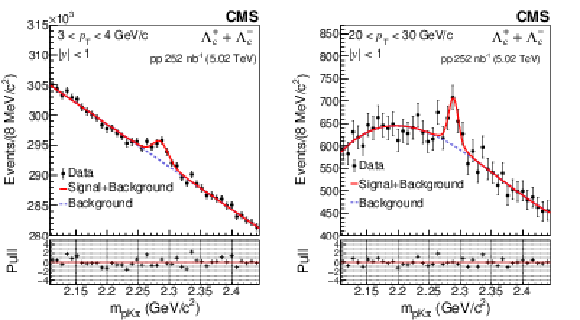
png pdf |
Figure 1:
The number of reconstructed $ \Lambda_{c}^{+} $ candidates per 8 MeVcc invariant mass in pp collisions for $ p_{\mathrm{T}}=$ 3-4 (left) and 20-30 GeV/$c$ (right). The solid line represents the fit to the data and the dashed line represents the fit to the background. The lower panels show the pulls, obtained as the difference between the data points and the fit result, divided by the uncertainty in data. |
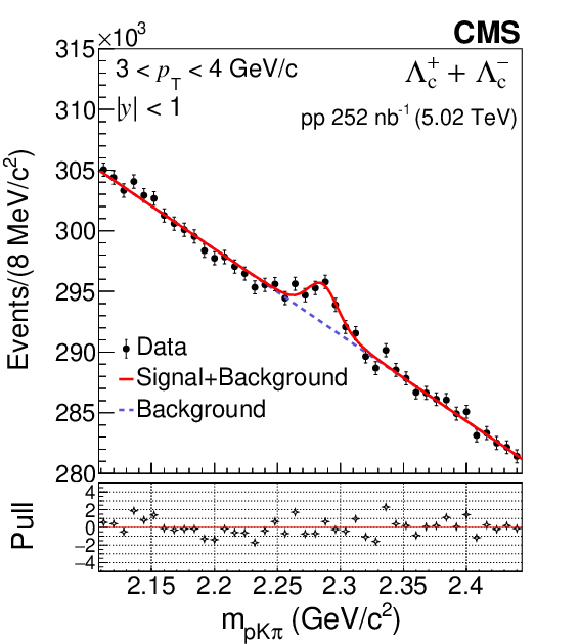
png pdf |
Figure 1-a:
The number of reconstructed $ \Lambda_{c}^{+} $ candidates per 8 MeVcc invariant mass in pp collisions for $ p_{\mathrm{T}}=$ 3-4 (left) and 20-30 GeV/$c$ (right). The solid line represents the fit to the data and the dashed line represents the fit to the background. The lower panels show the pulls, obtained as the difference between the data points and the fit result, divided by the uncertainty in data. |
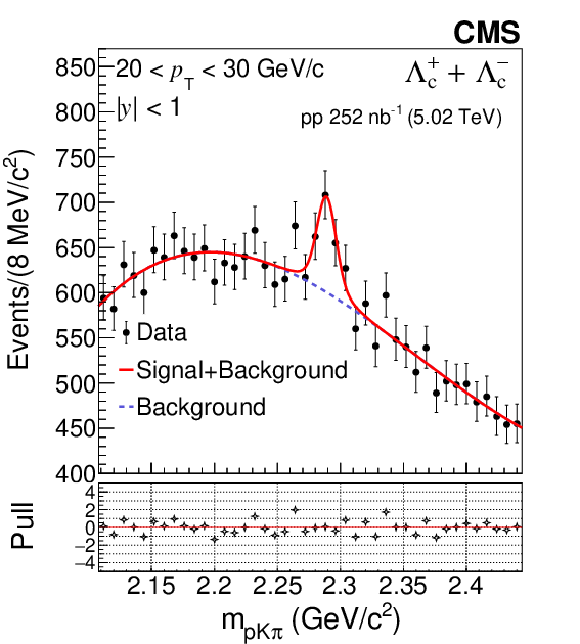
png pdf |
Figure 1-b:
The number of reconstructed $ \Lambda_{c}^{+} $ candidates per 8 MeVcc invariant mass in pp collisions for $ p_{\mathrm{T}}=$ 3-4 (left) and 20-30 GeV/$c$ (right). The solid line represents the fit to the data and the dashed line represents the fit to the background. The lower panels show the pulls, obtained as the difference between the data points and the fit result, divided by the uncertainty in data. |

png pdf |
Figure 2:
The number of reconstructed $ \Lambda_{c}^{+} $ candidates per 8 MeV/$c$ invariant mass in PbPb collisions for $ p_{\mathrm{T}}=$ 6-8 (left) and 30-40 GeV/$c$ (middle) in the 0-90% centrality bin, and for $ p_{\mathrm{T}}=$ 10-12.5 GeV/$c$ in the 0-10% (right) centrality bin. The solid line represents the fit to the data and the dashed line represents the contribution from the combinatorial background. The lower panels show the pulls, obtained as the difference between the data points and the fit result, divided by the uncertainty in data. |
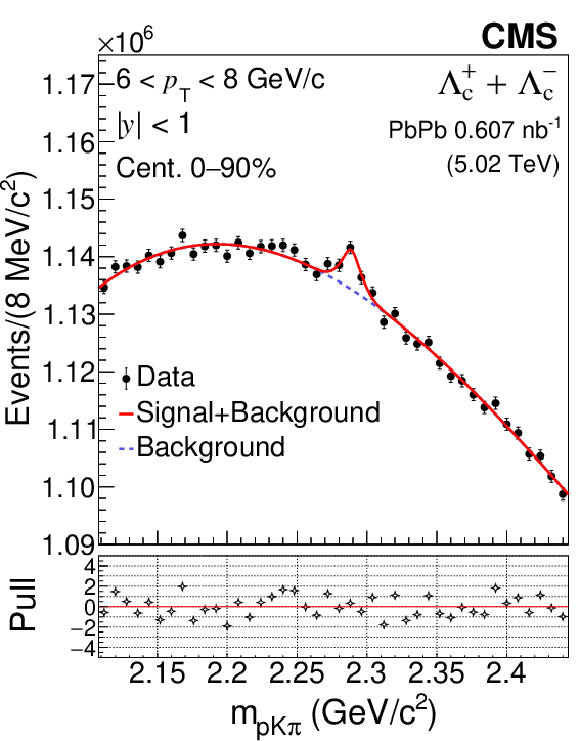
png pdf |
Figure 2-a:
The number of reconstructed $ \Lambda_{c}^{+} $ candidates per 8 MeV/$c$ invariant mass in PbPb collisions for $ p_{\mathrm{T}}=$ 6-8 (left) and 30-40 GeV/$c$ (middle) in the 0-90% centrality bin, and for $ p_{\mathrm{T}}=$ 10-12.5 GeV/$c$ in the 0-10% (right) centrality bin. The solid line represents the fit to the data and the dashed line represents the contribution from the combinatorial background. The lower panels show the pulls, obtained as the difference between the data points and the fit result, divided by the uncertainty in data. |
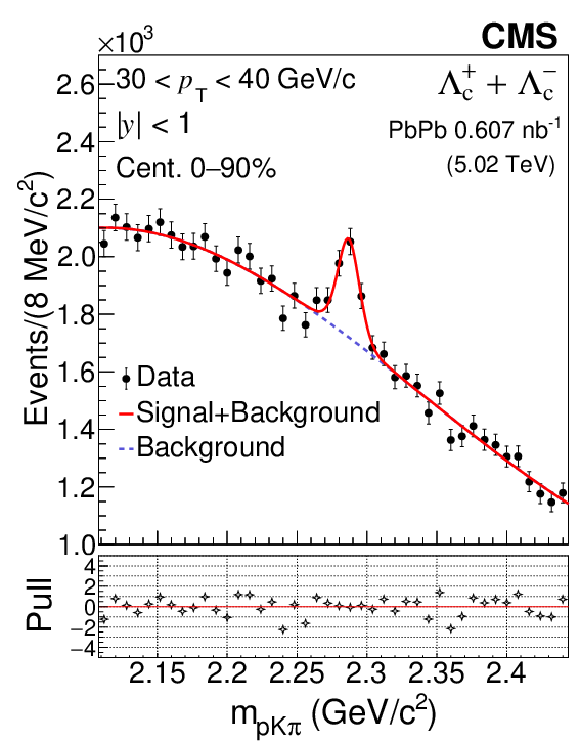
png pdf |
Figure 2-b:
The number of reconstructed $ \Lambda_{c}^{+} $ candidates per 8 MeV/$c$ invariant mass in PbPb collisions for $ p_{\mathrm{T}}=$ 6-8 (left) and 30-40 GeV/$c$ (middle) in the 0-90% centrality bin, and for $ p_{\mathrm{T}}=$ 10-12.5 GeV/$c$ in the 0-10% (right) centrality bin. The solid line represents the fit to the data and the dashed line represents the contribution from the combinatorial background. The lower panels show the pulls, obtained as the difference between the data points and the fit result, divided by the uncertainty in data. |
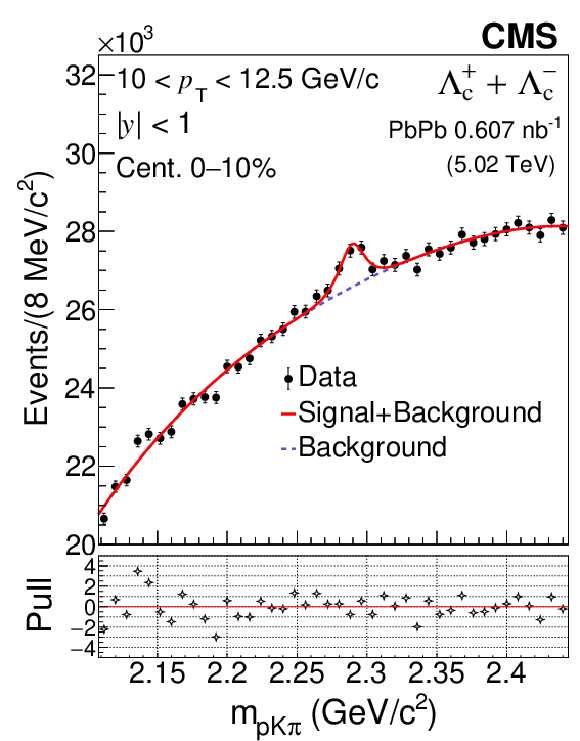
png pdf |
Figure 2-c:
The number of reconstructed $ \Lambda_{c}^{+} $ candidates per 8 MeV/$c$ invariant mass in PbPb collisions for $ p_{\mathrm{T}}=$ 6-8 (left) and 30-40 GeV/$c$ (middle) in the 0-90% centrality bin, and for $ p_{\mathrm{T}}=$ 10-12.5 GeV/$c$ in the 0-10% (right) centrality bin. The solid line represents the fit to the data and the dashed line represents the contribution from the combinatorial background. The lower panels show the pulls, obtained as the difference between the data points and the fit result, divided by the uncertainty in data. |
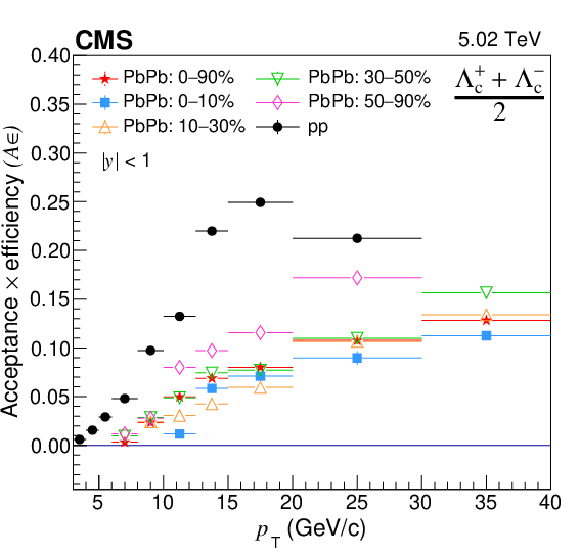
png pdf |
Figure 3:
The product of acceptance and efficiency ($ A\epsilon $) as a function of $ p_{\mathrm{T}} $ for prompt $ \Lambda_{c}^{+} $ in pp and PbPb collisions. The closed circles represent the value for pp. The $ A\epsilon $ values for PbPb collisions in centrality bins 0-90, 0-10, 10-30, 30-50 and 50-90% are represented by symbols of star, square, triangle, inverted triangle, and diamond, respectively. The horizontal error bars represent the bin widths. |
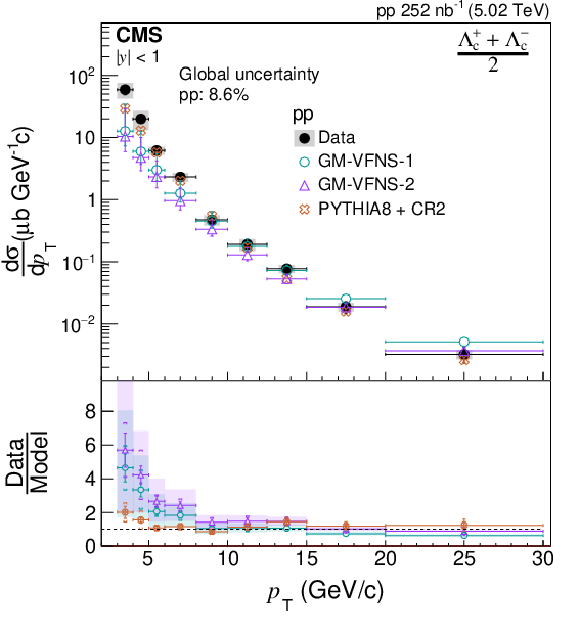
png pdf |
Figure 4:
The $ p_{\mathrm{T}} $-differential cross sections for prompt $ \Lambda_{c}^{+} $ production in pp collisions. Predictions for pp collisions are displayed for PYTHIA 8 with CR2 (open crosses), GM-VFNS implementing fragmentation functions that are fitted to the OPAL data, only (open circles labeled GM-VFNS-1), and fitted to both OPAL and Belle data (open triangles labeled GM-VFNS-2). The GM-VFNS model calculations are for inclusive $ \Lambda_{c}^{+} $ production. The horizontal error bars represent the bin widths. The vertical lines in the data points represent the statistical uncertainties and the shaded boxes represent the systematic uncertainties. The vertical lines in the model points represent the GM-VFNS uncertainties. The lower panel shows the data-to-prediction ratio for pp collisions with error bars and brackets corresponding to the statistical and total uncertainties in the data, respectively. The global fit uncertainty of 8.6% is not shown in the plot. The shaded boxes in the lower panel represent the GM-VFNS uncertainties. |

png pdf |
Figure 5:
The $ p_{\mathrm{T}} $-differential cross sections for prompt $ \Lambda_{c}^{+} $ production in pp collisions (circles) and the $ T_{\mathrm{AA}} $-scaled yields for PbPb collisions within centrality regions of 0-90 (stars), 0-10 (squares), 10-30 (triangles), 30-50 (inverted triangles) and 50-90% (diamonds) in PbPb collisions. The boxes and error bars represent the systematic and statistical uncertainties, respectively. The horizontal error bars represent the bin widths. |
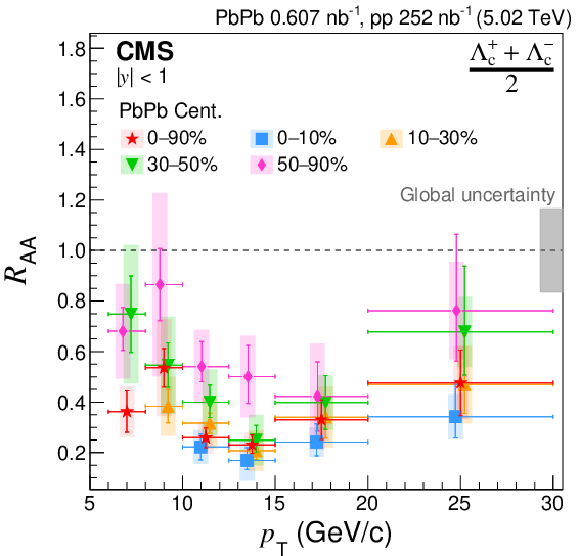
png pdf |
Figure 6:
The nuclear modification factor $ R_{\mathrm{AA}} $ versus $ p_{\mathrm{T}} $ for prompt $ \Lambda_{c}^{+} $ production in centrality regions of 0-90 (stars), 0-10 (squares), 10-30 (triangles), 30-50 (inverted triangles) and 50-90% (diamonds) in PbPb collisions. The mean position of the data points are shifted along the horizontal axis for clarity. The boxes and error bars represent the systematic and statistical uncertainties, respectively. The horizontal error bars represent the bin widths. The band at unity labeled global uncertainty includes the uncertainties for the luminosity of pp collisions, the number of MB events in PbPb collisions, and the tracking efficiency. The global uncertainty for $ R_{\mathrm{AA}} $ is 16.5%. |
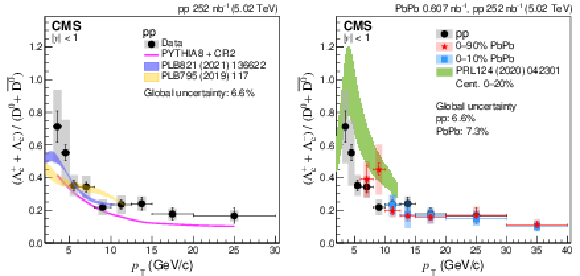
png pdf |
Figure 7:
The ratio of the production cross sections of prompt $ \Lambda_{c}^{+} $ to prompt $ \mathrm{D^0} $ versus $ p_{\mathrm{T}} $ from pp collisions is represented by closed circles (left). The ratio for 0-90 (closed stars) and 0-10% (closed squares) centrality classes of PbPb collisions are compared to the pp result (right). The boxes and error bars represent the systematic and statistical uncertainties, respectively. The horizontal error bars represent the bin widths. The 6.6 and 7.3% normalization uncertainties in pp and PbPb collisions, respectively, are not included in the boxes representing the systematic uncertainties for each data point. Model calculations are displayed (see text for details). |
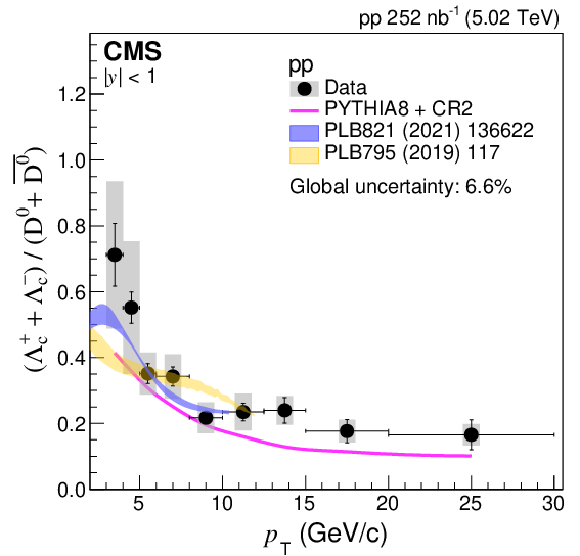
png pdf |
Figure 7-a:
The ratio of the production cross sections of prompt $ \Lambda_{c}^{+} $ to prompt $ \mathrm{D^0} $ versus $ p_{\mathrm{T}} $ from pp collisions is represented by closed circles (left). The ratio for 0-90 (closed stars) and 0-10% (closed squares) centrality classes of PbPb collisions are compared to the pp result (right). The boxes and error bars represent the systematic and statistical uncertainties, respectively. The horizontal error bars represent the bin widths. The 6.6 and 7.3% normalization uncertainties in pp and PbPb collisions, respectively, are not included in the boxes representing the systematic uncertainties for each data point. Model calculations are displayed (see text for details). |

png pdf |
Figure 7-b:
The ratio of the production cross sections of prompt $ \Lambda_{c}^{+} $ to prompt $ \mathrm{D^0} $ versus $ p_{\mathrm{T}} $ from pp collisions is represented by closed circles (left). The ratio for 0-90 (closed stars) and 0-10% (closed squares) centrality classes of PbPb collisions are compared to the pp result (right). The boxes and error bars represent the systematic and statistical uncertainties, respectively. The horizontal error bars represent the bin widths. The 6.6 and 7.3% normalization uncertainties in pp and PbPb collisions, respectively, are not included in the boxes representing the systematic uncertainties for each data point. Model calculations are displayed (see text for details). |
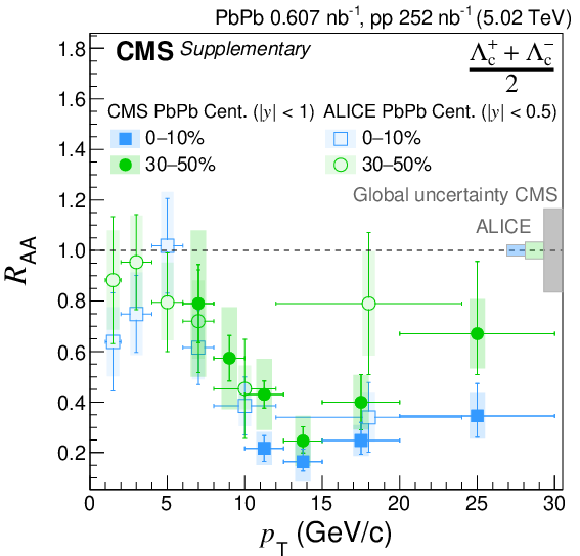
png pdf |
Figure 8:
The nuclear modification factor $ R_{\mathrm{AA}} $ vs. $ p_{\mathrm{T}} $ for $ \Lambda_{c}^{+} $ production in PbPb collisions. Results are shown for the 0-10 (closed squares) and 30-50% (closed circles) centrality ranges. Also shown are the published results from the ALICE Collaboration [27] for the same centrality ranges with open markers. The boxes and error bars represent the statistical and point-to-point systematic uncertainties, respectively. Global systematic uncertainties are indicated by the bands at unity. For CMS (gray band) this includes the uncertainties in the pp collision luminosity, the number of PbPb MB events, and the tracking efficiency. The global systematic uncertainties for the ALICE results (color bands) are shown separately for the two centrality ranges. |
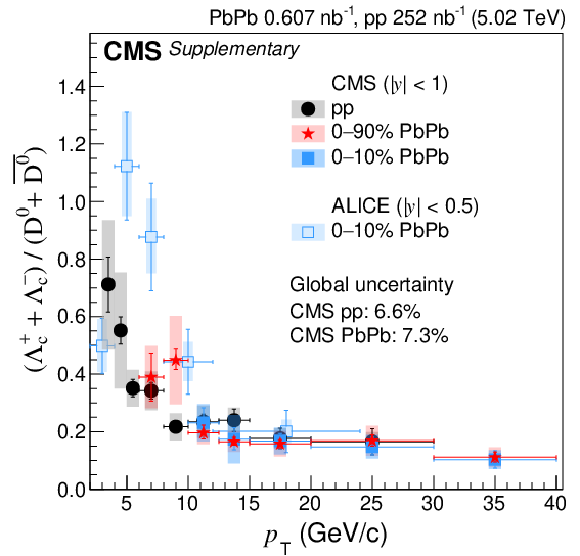
png pdf |
Figure 9:
The ratio of the production cross sections of prompt $ \Lambda_{c}^{+} $ to prompt $ \mathrm{D^0} $ versus $ p_{\mathrm{T}} $ in pp collisions is represented by the closed circles. The ratio for the 0-90 (closed stars) and 0-10% (closed squares) centrality classes in PbPb collisions are compared to the pp result. The boxes and error bars represent the systematic and statistical uncertainties, respectively. The horizontal error bars represent the bin widths. The 6.6 and 7.3% normalization uncertainties in pp and PbPb collisions, respectively, are not included in the boxes representing the systematic uncertainties for each data point. Results from the ALICE Collaboration [27] for PbPb collisions in the 0-10% centrality class are also shown using the open square markers. |
| Tables | |

png pdf |
Table 1:
Systematic uncertainties from different sources. |
| Summary |
| The differential cross section of prompt $ \Lambda_{c}^{+} $ baryons as a function of transverse momentum ($ p_{\mathrm{T}} $) is presented for both proton-proton (pp) and lead-lead (PbPb) collisions at a center-of-mass energy per nucleon pair of 5.02 TeV in the central rapidity region $ |y| < $ 1. The measured $ p_{\mathrm{T}} $ ranges are 3-30 GeV/$c$ and 6-40 GeV/$c$ for the pp and PbPb collisions, respectively. The $ p_{\mathrm{T}} $ range of the pp and PbPb results, together with the differential centrality study of the prompt $ \Lambda_{c}^{+} $ production, significantly extend previous CMS results based on 2015 data that was obtained with a lower integrated luminosity. The $ \Lambda_{c}^{+} $ baryon yields for pp collisions are much higher than predicted by calculations with the general-mass variable-flavor-number scheme that use fragmentation functions obtained by fitting results from the OPAL and Belle Collaborations, indicating a breakdown of the universality of charm quark fragmentation functions. The nuclear modification factors, which correspond to the $ \Lambda_{c}^{+} $ yields divided by the pp yields scaled up by the number of nucleon-nucleon collisions, have been measured in various centrality classes for the PbPb collisions. The prompt $ \Lambda_{c}^{+} $ production for PbPb collisions is significantly suppressed compared to the pp collision results. The suppression magnitude is larger in more central collisions and shows a hint of varying with the $ \Lambda_{c}^{+} $ baryon $ p_{\mathrm{T}} $. This is consistent with the partonic energy loss affecting charm quarks in the quark-gluon plasma. A similar effect was previously observed for (charmed) $ \mathrm{D^0} $ mesons and many other hadrons. The $ \Lambda_{c}^{+}/ \mathrm{D^0} $ production ratio is measured for pp collisions with $ p_{\mathrm{T}} $ in the range 3-30 GeV/$c$, 0-90% centrality PbPb collisions with $ p_{\mathrm{T}} $ in the range 6-40 GeV/$c$, and 0-10% centrality PbPb collisions with $ p_{\mathrm{T}} $ in the range 10-40 GeV/$c$. Calculations based on the event generator PYTHIA 8 for the $ \Lambda_{c}^{+}/ \mathrm{D^0} $ production ratio with the inclusion of color reconnection (mode 2) in the hadronization step can describe the pp data well for $ p_{\mathrm{T}} < $ 10 GeV/$c$, but are systematically lower for 10 $ < p_{\mathrm{T}} < $ 30 GeV/$c$. A model taking into account the contributions from the decays of excited charm baryons and a model involving both coalescence and fragmentation can also describe the $ \Lambda_{c}^{+}/ \mathrm{D^0} $ production ratios in pp collisions. For $ p_{\mathrm{T}} > $ 10 GeV/$c$, the $ \Lambda_{c}^{+}/ \mathrm{D^0} $ ratios for pp and PbPb collisions are consistent with each other and approach the value found for $ \mathrm{e}^+\mathrm{e}^- $ collisions, suggesting that the coalescence process does not play a significant role in $ \Lambda_{c}^{+} $ baryon production in this higher-$ p_{\mathrm{T}} $ region. |
| References | ||||
| 1 | E. V. Shuryak | Theory of hadronic plasma | Sov. Phys. JETP 47 (1978) 212 | |
| 2 | A. Andronic et al. | Heavy-flavour and quarkonium production in the LHC era: From proton-proton to heavy-ion collisions | EPJC 76 (2016) 107 | 1506.03981 |
| 3 | F. Prino and R. Rapp | Open heavy flavor in QCD matter and in nuclear collisions | JPG 43 (2016) 093002 | 1603.00529 |
| 4 | X. Dong and V. Greco | Heavy quark production and properties of Quark-Gluon Plasma | Prog. Part. Nucl. Phys. 104 (2019) 97 | |
| 5 | X. Dong, Y.-J. Lee, and R. Rapp | Open heavy-flavor production in heavy-ion collisions | Ann. Rev. Nucl. Part. Sci. 69 (2019) 417 | 1903.07709 |
| 6 | W. Busza, K. Rajagopal, and W. van der Schee | Heavy ion collisions: The big picture, and the big questions | Ann. Rev. Nucl. Part. Sci. 68 (2018) 339 | 1802.04801 |
| 7 | L. Apolinário, Y.-J. Lee, and M. Winn | Heavy quarks and jets as probes of the QGP | Prog. Part. Nucl. Phys. 127 (2022) 103990 | 2203.16352 |
| 8 | A. Beraudo et al. | Extraction of heavy-flavor transport coefficients in QCD matter | Nucl. Phys. A 979 (2018) 21 | 1803.03824 |
| 9 | B. Andersson, G. Gustafson, G. Ingelman, and T. Sjöstrand | Parton fragmentation and string dynamics | Phys. Rept. 97 (1983) 31 | |
| 10 | V. Greco, C. M. Ko, and P. Lévai | Parton coalescence and the antiproton/pion anomaly at RHIC | PRL 90 (2003) 202302 | nucl-th/0301093 |
| 11 | R. J. Fries, V. Greco, and P. Sorensen | Coalescence models for hadron formation from quark gluon plasma | Ann. Rev. Nucl. Part. Sci. 58 (2008) 177 | 0807.4939 |
| 12 | Y. Oh, C. M. Ko, S. H. Lee, and S. Yasui | Ratios of heavy baryons to heavy mesons in relativistic nucleus-nucleus collisions | Phys. Rev. C 79 (2009) 044905 | 0901.1382 |
| 13 | S. H. Lee et al. | $ \Lambda_\text{c} $ enhancement from strongly coupled quark-gluon plasma | PRL 100 (2008) 222301 | 0709.3637 |
| 14 | S. Ghosh et al. | Diffusion of $ \Lambda_\text{c} $ in hot hadronic medium and its impact on $ \Lambda_\text{c}/D $ ratio | PRD 90 (2014) 054018 | 1407.5069 |
| 15 | S. Plumari et al. | Charmed hadrons from coalescence plus fragmentation in relativistic nucleus-nucleus collisions at RHIC and LHC | EPJC 78 (2018) 348 | 1712.00730 |
| 16 | ALICE Collaboration | $ \Lambda_\text{c}^+ $ production in pp collisions at $ \sqrt{s} = $ 7 TeV and in p-Pb collisions at $ \sqrt{\smash[b]{s_{_{\mathrm{NN}}}}} = $ 5.02 TeV | JHEP 04 (2018) 108 | 1712.09581 |
| 17 | ALICE Collaboration | $ \Lambda_\text{c}^+ $ production and baryon-to-meson ratios in pp and p-Pb collisions at $ \sqrt{s} = $ 5.02 TeV at the LHC | PRL 127 (2021) 202301 | 2011.06078 |
| 18 | CMS Collaboration | Production of $ \Lambda_\mathrm{c}^+ $ baryons in proton-proton and lead-lead collisions at $ \sqrt{\smash[b]{s_{_{\mathrm{NN}}}}} = $ 5.02 TeV | PLB 803 (2020) 135328 | CMS-HIN-18-009 1906.03322 |
| 19 | LHCb Collaboration | Prompt charm production in pp collisions at $ \sqrt{s} = $ 7 TeV | NPB 871 (2013) 1 | 1302.2864 |
| 20 | M. A. G. Aivazis, J. C. Collins, F. I. Olness, and W.-K. Tung | Leptoproduction of heavy quarks. II. A unified QCD formulation of charged and neutral current processes from fixed-target to collider energies | PRD 50 (1994) 3102 | |
| 21 | M. Benzke et al. | Prompt neutrinos from atmospheric charm in the general-mass variable-flavor-number scheme | JHEP 12 (2017) 021 | 1705.10386 |
| 22 | J. R. Christiansen and P. Z. Skands | String formation beyond leading colour | JHEP 08 (2015) 003 | 1505.01681 |
| 23 | LHCb Collaboration | Prompt $ \Lambda^+_c $ production in pPb collisions at $ \sqrt{\smash[b]{s_{_{\mathrm{NN}}}}} = $ 5.02 TeV | JHEP 02 (2019) 102 | 1809.01404 |
| 24 | STAR Collaboration | First measurement of $ \Lambda_\text{c}^+ $ baryon production in Au+Au collisions at $ \sqrt{\smash[b]{s_{_{\mathrm{NN}}}}} = $ 200 GeV | PRL 124 (2020) 172301 | 1910.14628 |
| 25 | T. Sjöstrand et al. | An introduction to PYTHIA 8.2 | Comput. Phys. Commun. 191 (2015) 159 | 1410.3012 |
| 26 | ALICE Collaboration | $ \Lambda_\text{c}^+ $ production in Pb-Pb collisions at $ \sqrt{\smash[b]{s_{_{\mathrm{NN}}}}} = $ 5.02 TeV | PLB 793 (2019) 212 | 1809.10922 |
| 27 | ALICE Collaboration | Constraining hadronization mechanisms with $ \Lambda_\text{c}^{+}/D^0 $ production ratios in Pb-Pb collisions at $ \sqrt{\smash[b]{s_{_{\mathrm{NN}}}}} = $ 5.02 TeV | PLB 839 (2023) 137796 | 2112.08156 |
| 28 | CMS Collaboration | Evidence for X(3872) in Pb-Pb collisions and studies of its prompt production at $ \sqrt{\smash[b]{s_{_{\mathrm{NN}}}}} = $ 5.02 TeV | PRL 128 (2022) 032001 | CMS-HIN-19-005 2102.13048 |
| 29 | CMS Collaboration | Observation of the $ {B}_\mathrm{c}^{+} $ meson in Pb-Pb and pp collisions at $ \sqrt{\smash[b]{s_{_{\mathrm{NN}}}}} = $ 5.02 TeV and measurement of its nuclear modification factor | PRL 128 (2022) 252301 | CMS-HIN-20-004 2201.02659 |
| 30 | CMS Collaboration | CMS luminosity measurement using nucleus-nucleus collisions at $ \sqrt{\smash[b]{s_{_{\mathrm{NN}}}}} = $ 5.02 TeV in 2018 | CMS Physics Analysis Summary, 2022 CMS-PAS-LUM-18-001 |
CMS-PAS-LUM-18-001 |
| 31 | CMS Collaboration | Luminosity measurement in proton-proton collisions at 5.02 TeV in 2017 at CMS | CMS Physics Analysis Summary, 2021 CMS-PAS-LUM-19-001 |
CMS-PAS-LUM-19-001 |
| 32 | CMS Collaboration | Precision luminosity measurement in proton-proton collisions at $ \sqrt{s} = $ 13 TeV in 2015 and 2016 at CMS | EPJC 81 (2021) 800 | CMS-LUM-17-003 2104.01927 |
| 33 | M. He and R. Rapp | Charm-baryon production in proton-proton collisions | PLB 795 (2019) 117 | 1902.08889 |
| 34 | CMS Collaboration | Nuclear modification factor of D$ ^0 $ mesons in PbPb collisions at $ \sqrt{\smash[b]{s_{_{\mathrm{NN}}}}} = $ 5.02 TeV | PLB 782 (2018) 474 | CMS-HIN-16-001 1708.04962 |
| 35 | CMS Collaboration | HEPData record for this analysis | link | |
| 36 | CMS Collaboration | Description and performance of track and primary-vertex reconstruction with the CMS tracker | JINST 9 (2014) P10009 | CMS-TRK-11-001 1405.6569 |
| 37 | CMS Collaboration | The CMS experiment at the CERN LHC | JINST 3 (2008) S08004 | |
| 38 | CMS Collaboration | Charged-particle nuclear modification factors in PbPb and pPb collisions at $ \sqrt{\smash[b]{s_{_{\mathrm{NN}}}}} = $ 5.02 TeV | JHEP 04 (2017) 039 | CMS-HIN-15-015 1611.01664 |
| 39 | CMS Collaboration | Transverse-momentum and pseudorapidity distributions of charged hadrons in pp collisions at $ \sqrt{s} = $ 0.9 and 2.36 TeV | JHEP 02 (2010) 041 | CMS-QCD-09-010 1002.0621 |
| 40 | CMS Collaboration | The CMS trigger system | JINST 12 (2017) P01020 | CMS-TRG-12-001 1609.02366 |
| 41 | CMS Collaboration | Event generator tunes obtained from underlying event and multiparton scattering measurements | EPJC 76 (2016) 155 | CMS-GEN-14-001 1512.00815 |
| 42 | I. P. Lokhtin and A. M. Snigirev | A model of jet quenching in ultrarelativistic heavy ion collisions and high-$ p_{\mathrm{T}} $ hadron spectra at RHIC | EPJC 45 (2006) 211 | hep-ph/0506189 |
| 43 | D. J. Lange | The EvtGen particle decay simulation package | NIM A 462 (2001) 152 | |
| 44 | Particle Data Group Collaboration | Review of particle physics | PTEP 2022 (2022) 083C01 | |
| 45 | GEANT4 Collaboration | GEANT 4---a simulation toolkit | NIM A 506 (2003) 250 | |
| 46 | E. L. Lehmann | On likelihood ratio tests | in Institute of Mathematical Statistics Lecture Notes - Monograph Series, volume~49, . Institute of Mathematical Statistics, 2006 link |
math/0610835 |
| 47 | M. Cacciari, M. Greco, and P. Nason | The $ p_{\mathrm{T}} $ spectrum in heavy flavor hadroproduction | JHEP 05 (1998) 007 | hep-ph/9803400 |
| 48 | CMS Collaboration | Measurement of the differential inclusive $ \mathrm{B}^{+} $ hadron cross sections in pp collisions at $ \sqrt{s}= $ 13 TeV | PLB 771 (2017) 435 | CMS-BPH-15-004 1609.00873 |
| 49 | M. L. Miller, K. Reygers, S. J. Sanders, and P. Steinberg | Glauber modeling in high-energy nuclear collisions | Ann. Rev. Nucl. Part. Science 57 (2007) 205 | nucl-ex/0701025 |
| 50 | CMS Collaboration | Measurement of the $ {B}^{\pm} $ meson nuclear modification factor in Pb-Pb collisions at $ \sqrt{\smash[b]{s_{_{\mathrm{NN}}}}} = $ 5.02 TeV | PRL 119 (2017) 152301 | CMS-HIN-16-011 1705.04727 |
| 51 | B. Kniehl, G. Kramer, I. Schienbein, and H. Spiesberger | $ \Lambda_{c}^{+} $ production in pp collisions with a new fragmentation function | PRD 101 (2020) 114021 | 2004.04213 |
| 52 | OPAL Collaboration | A study of charm hadron production in $ Z^0 \to c\bar c $ and $ Z^0 \to b\bar b $ decays at LEP | Z. Phys. C, Particles and Fields, 72 (1996) 1 | |
| 53 | Belle Collaboration | Charm hadrons from fragmentation and $ b $ decays in $ {e}^{+}{e}^{-} $ annihilation at $ \sqrt{s}=$ 10.6 GeV | PRD 73 (2006) 032002 | hep-ex/0506068 |
| 54 | CMS Collaboration | Studies of beauty suppression via nonprompt $ \mathrm{D^0} $ mesons in Pb-Pb collisions at $ \sqrt{\smash[b]{s_{_{\mathrm{NN}}}}} = $ 5.02 TeV | PRL 123 (2019) 022001 | CMS-HIN-16-016 1810.11102 |
| 55 | V. Minissale, S. Plumari, and V. Greco | Charm hadrons in pp collisions at LHC energy within a coalescence plus fragmentation approach | PLB 821 (2021) 136622 | 2012.12001 |
| 56 | M. He and R. Rapp | Hadronization and charm-hadron ratios in heavy-ion collisions | PRL 124 (2020) 042301 | 1905.09216 |

|
Compact Muon Solenoid LHC, CERN |

|

|

|

|

|

|